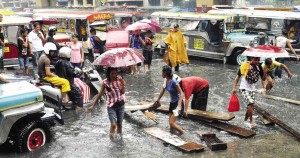
It’s the beginning of chaos on CM Recto Avenue in Manila, where enterprising men place wooden planks on the pavement for pedestrians who wish to avoid the ankle-deep flood. EDWIN BELLOSILLO
He strongly protested when the novelist Dan Brown described Metro Manila as the “gates of hell,” but there are really hellish places that even his own cleanup and flood-control teams can’t enter.
As flash floods once again paralyzed parts of the capital on Thursday, the head of the Metropolitan Manila Development Authority (MMDA) said the agency had yet to clear at least 10 major waterways of garbage because of the thick squatter colonies blocking the way.
MMDA Chairman Francis Tolentino complained that several esteros or creeks had been rendered “impenetrable” by the very residents who filled them with trash, a perennial cause of flooding that most local governments seem powerless to address.
“We can’t bring our equipment into the waterways because several houses stood there right in the middle,” Tolentino told reporters.
An example of a Manila estero where trash had completely covered the water surface. Photo taken in January in Barangay 264, Zone 24, in Sta. Cruz. INQUIRER PHOTO
The MMDA chief vented his frustrations as a heavy afternoon downpour triggered flash floods, snarled traffic and caused the suspension of classes particularly in the city of Manila, where most of the trash-choked creeks cited by Tolentino are located.
Among them were Estero de Maypajo from Rizal Avenue to Estero de Sunog, where he said shanties built by some 1,400 informal settlers had mushroomed. He also cited portions of Estero de Sampaloc from Legarda to Lacson streets, also in Manila.
The other creeks yet to be accessed by the MMDA cleanup drive are Estero de Valencia, De Quiapo, De Alix, De Pandacan, De Magdalena, De San Lazaro, De la Reina and Sta. Clara.
Tolentino warned that Estero de Sampaloc, for example, could easily overflow because of the garbage and cause floods in areas along Manila’s University Belt.
“The public should understand this,” he said, stressing that the only way to solve the problem is to relocate the informal settlers, which remains a challenge for the agency.
“We are asking residents along those creeks to relocate voluntarily. Recently, we moved 50 families from Las Piñas City to Laguna province, but the number is still small compared to those who are ignoring the government’s proposal,” he said.
On May 28, the MMDA launched a massive cleanup drive on the waterways in preparation for the rainy season, and collected a staggering 169 truckloads of trash in the first nine days.
Tolentino on Thursday said the cleanup had so far covered 80 percent of the 273 waterways in the metropolis.
He added that the garbage and the shanties blocking the esteros cause flood-control facilities like pumping stations to “underperform.” Worse, the stations end up pumping out trash instead of water, he said.
As of 5 p.m., the MMDA said heavy rains had rendered five major roads impassable to light vehicles.
Bobot Balbaboco, team leader at the agency’s Flood Control Information Center, said the flood rose to almost 20 inches on España Boulevard and 12 inches on Lacson Street. He also mentioned R. Papa Avenue, Amoranto Street and Maceda Street, all in Manila.
Flooding was also reported in Quezon City, where classes were suspended around 4 p.m., and in the cities of Caloocan, Navotas and Mandaluyong.
The Manila City government was also forced to suspend classes on all levels around 3 p.m. and deployed trucks for the stranded commuters. The flood was two feet high on Taft Avenue, where many Manila campuses are located.—With reports from Nancy Carvajal, Jeannette Andrade and Kristine Felisse Mangunay